Bird R.B., Stewart W.E., Lightfoot E.N. Transport Phenomena
Подождите немного. Документ загружается.

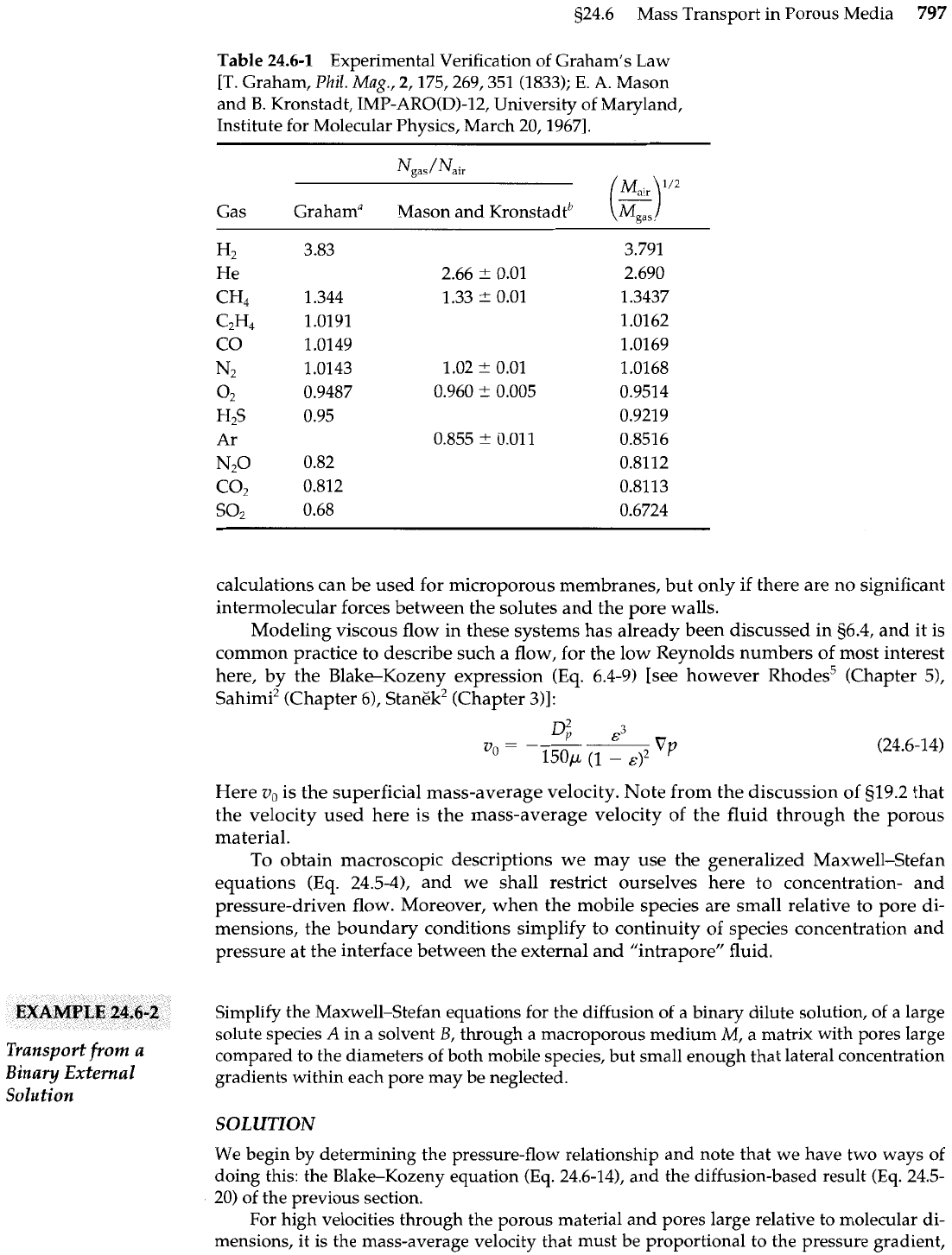
s24.6 Mass Transport in Porous Media
797
Table
24.6-1
Experimental Verification of Graham's Law
IT.
Graham,
Phil.
Mag., 2,175,269,351 (1833);
E.
A.
Mason
and
B.
Kronstadt, IMP-ARO(D)-12, University of Maryland,
Institute for Molecular Physics, March 20,19671.
Gas Grahama Mason and ~ronstadtl'
\%)
calculations can be used for microporous membranes, but only if there are no significant
intermolecular forces between the solutes and the pore walls.
Modeling viscous flow in these systems has already been discussed in 56.4, and it is
common practice to describe such a flow, for the low Reynolds numbers of most interest
here, by the Blake-Kozeny expression (Eq. 6.4-9) [see however Rhodes5 (Chapter
5),
Sahimi2 (Chapter 6), Stanitk2 (Chapter
3)]:
Here
v,
is the superficial mass-average velocity. Note from the discussion of 519.2 that
the velocity used here is the mass-average velocity of the fluid through the porous
material.
To obtain macroscopic descriptions we may use the generalized Maxwell-Stefan
equations (Eq. 24.5-4), and we shall restrict ourselves here to concentration- and
pressure-driven flow. Moreover, when the mobile species are small relative to pore di-
mensions, the boundary conditions simplify to continuity of species concentration and
pressure at the interface between the external and "intrapore" fluid.
Simplify the Maxwell-Stefan equations for the diffusion of a binary dilute solution,
of
a large
solute species
A
in a solvent
B,
through a macroporous medium M, a matrix with pores large
Transport *om a
compared to the diameters of both mobile species, but small enough that lateral concentration
Binary External
gradients within each pore may be neglected.
Solution
SOLUTION
We begin by determining the pressure-flow relationship and note that we have two ways of
doing this: the Blake-Kozeny equation
(Eq.
24.6-14), and the diffusion-based result
(Eq.
24.5-
20) of the previous section.
For high velocities through the porous material and pores large relative to molecular di-
mensions, it is the mass-average velocity that must be proportional to the pressure gradient,
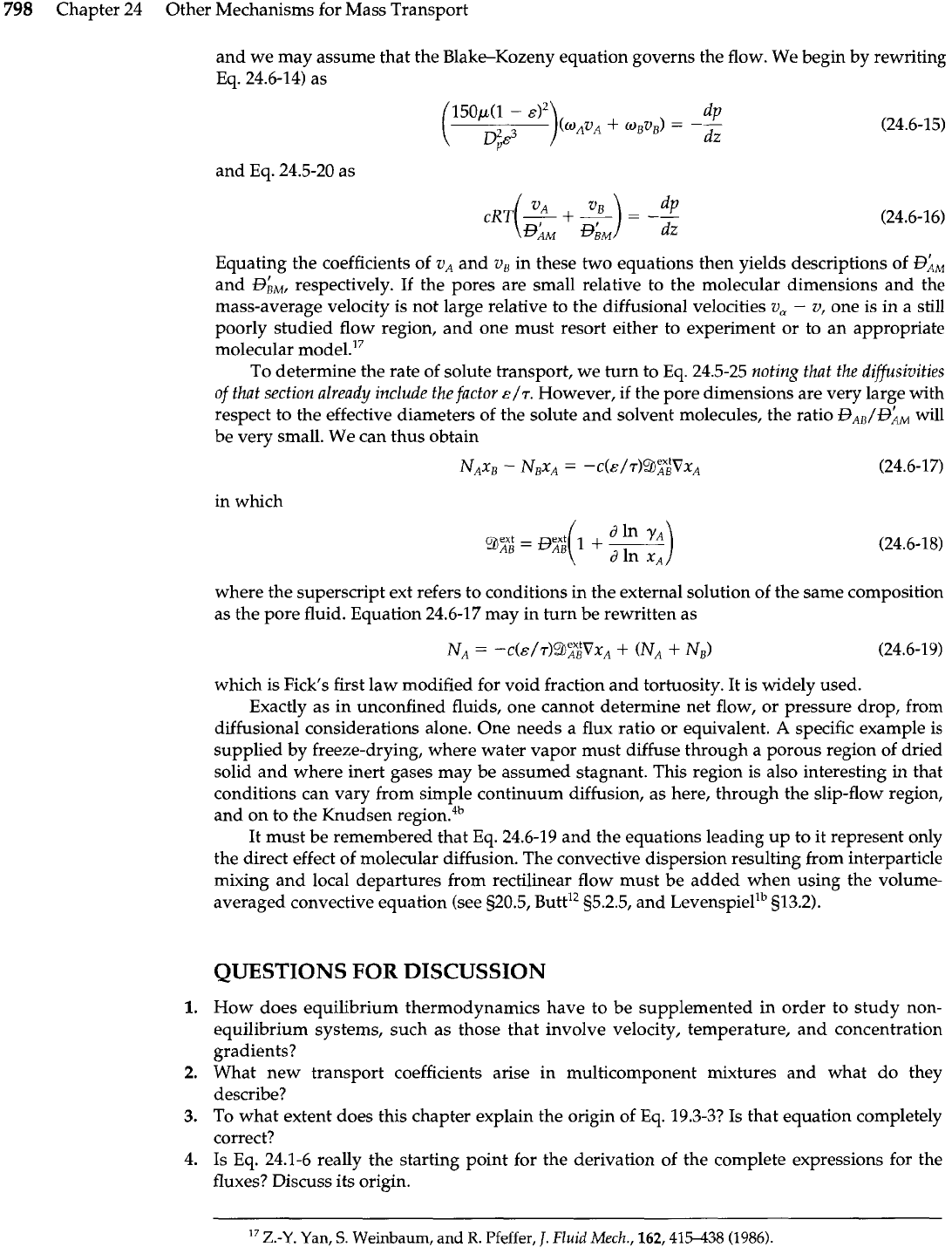
798
Chapter 24 Other Mechanisms for Mass Transport
and we may assume that the Blake-Kozeny equation governs the flow. We begin by rewriting
Eq. 24.6-14) as
and Eq. 24.5-20 as
Equating the coefficients of v, and
v,
in these two equations then yields descriptions of
Di,
and
BLM,
respectively. If the pores are small relative to the molecular dimensions and the
mass-average velocity is not large relative to the diffusional velocities v,
-
v,
one is in a still
poorly studied flow region, and one must resort either to experiment or to an appropriate
molecular model.17
To determine the rate of solute transport, we turn to
Eq.
24.5-25
noting that the diffusivities
of
that section already include the factor
E/T.
However, if the pore dimensions are very large with
respect to the effective diameters of the solute and solvent molecules, the ratio
BAB/BLM
will
be very small. We can thus obtain
in which
where the superscript ext refers to conditions in the external solution of the same composition
as the pore fluid. Equation 24.6-17 may in turn be rewritten as
which is Fick's first law modified for void fraction and tortuosity. It is widely used.
Exactly as in unconfined fluids, one cannot determine net flow, or pressure drop, from
diffusional considerations alone. One needs a
flux
ratio or equivalent.
A
specific example is
supplied by freeze-drying, where water vapor must diffuse through a porous region of dried
solid and where inert gases may be assumed stagnant. This region is also interesting in that
conditions can vary from simple continuum diffusion, as here, through the slip-flow region,
and on to the Knudsen region.4b
It must be remembered that Eq. 24.6-19 and the equations leading up to it represent only
the direct effect of molecular diffusion. The convective dispersion resulting from interparticle
mixing and local departures from rectilinear flow must be added when using the volume-
averaged convective equation (see 520.5, Butt12 g5.2.5, and ~evens~iel'~ 513.2).
QUESTIONS FOR DISCUSSION
How does equilibrium thermodynamics have to be supplemented in order to study non-
equilibrium systems, such as those that involve velocity, temperature, and concentration
gradients?
What new transport coefficients arise in multicomponent mixtures and what do they
describe?
To what extent does this chapter explain the origin of
Eq.
19.3-3? Is that equation completely
correct?
Is Eq. 24.1-6 really the starting point for the derivation of the complete expressions for the
fluxes? Discuss its origin.
l7
Z.-Y.
Yan,
S.
Weinbaum, and
R.
Pfeffer,
J.
Fluid
Mech.,
162,415438
(1986).
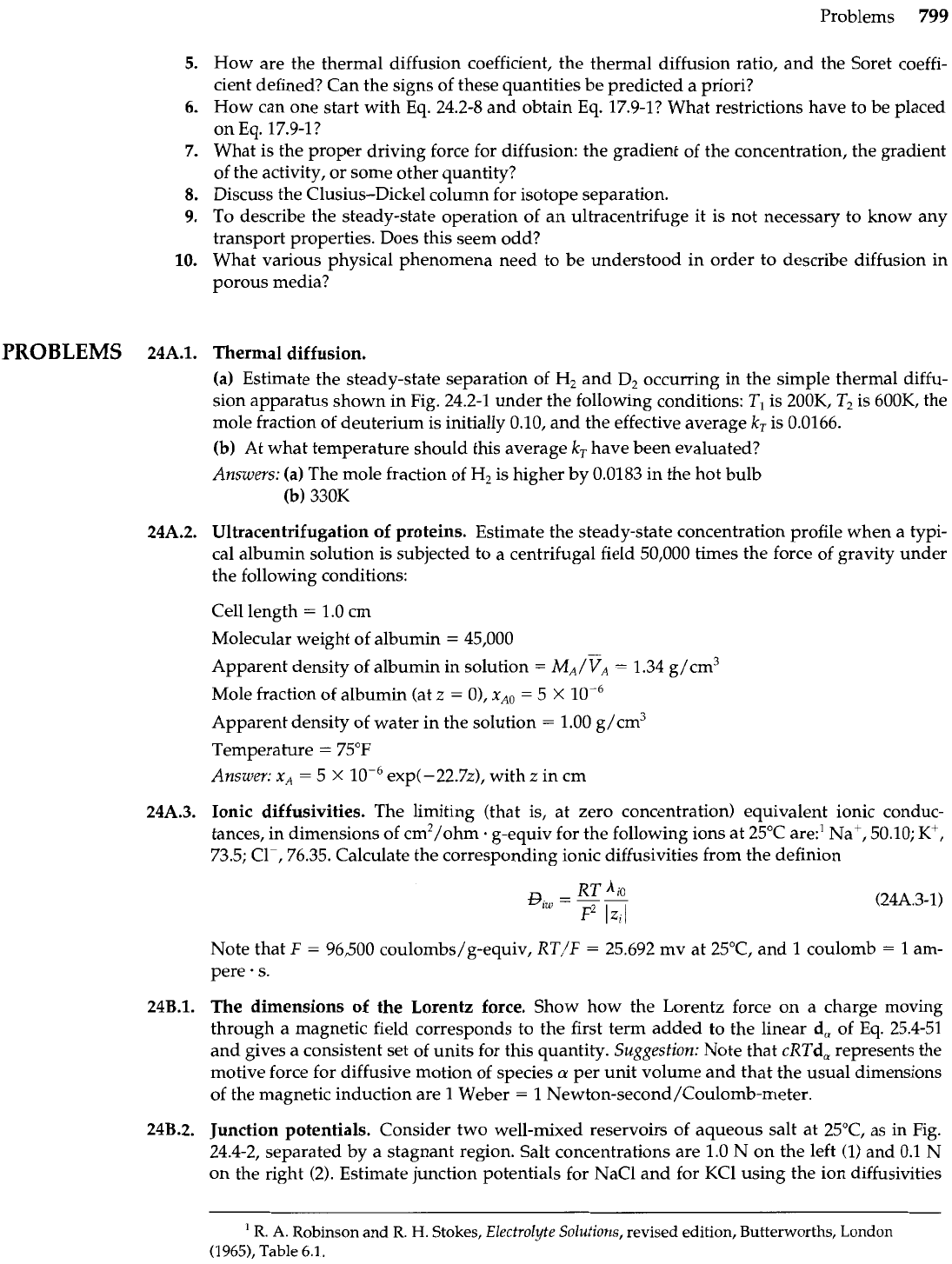
Problems
799
5.
How are the thermal diffusion coefficient, the thermal diffusion ratio, and the Soret coeffi-
cient defined? Can the signs of these quantities be predicted a priori?
6.
How can one start with
Eq.
24.2-8 and obtain Eq. 17.9-I? What restrictions have to be placed
on Eq. 17.9-I?
7.
What is the proper driving force for diffusion: the gradient of the concentration, the gradient
of the activity, or some other quantity?
8.
Discuss the Clusius-Dickel column for isotope separation.
9.
To describe the steady-state operation of an ultracentrifuge it is not necessary to know any
transport properties. Does this seem odd?
10.
What various physical phenomena need to be understood in order to describe diffusion in
porous media?
PROBLEMS
24A.1.
Thermal diffusion.
(a) Estimate the steady-state separation of
H,
and
D2
occurring in the simple thermal diffu-
sion apparatus shown in Fig. 24.2-1 under the following conditions:
T,
is 200K,
T,
is 600K, the
mole fraction of deuterium is initially 0.10, and the effective average
kT
is 0.0166.
(b) At what temperature should this average
kT
have been evaluated?
Answers:
(a) The mole fraction of
H2
is higher by 0.0183 in the hot bulb
(b) 330K
24A.2.
Ultracentrifugation of proteins. Estimate the steady-state concentration profile when a typi-
cal albumin solution is subjected to a centrifugal field 50,000 times the force of gravity under
the following conditions:
Cell length
=
1.0 cm
Molecular weight of albumin
=
45,000
Apparent density of albumin in solution
=
M~/V~
=
1.34 g/cm3
Mole fraction of albumin (at
z
=
O),
XAO
=
5
X
Apparent density of water in the solution
=
1.00 g/cm3
Temperature
=
75°F
Answer:
xA
=
5
X
exp(-22.7z), with
z
in cm
24A.3.
Ionic diffusivities. The limiting (that is, at zero concentration) equivalent ionic conduc-
tances, in dimensions of cm2/ohm
e
g-equiv for the following ions at 25°C are:' Na', 50.10;
K',
73.5; C1-, 76.35. Calculate the corresponding ionic diffusivities from the definion
Note that F
=
96,500 coulombs/g-equiv, RT/F
=
25.692 mv at 25OC, and
1
coulomb
=
1
am-
pere. s.
24B.1.
The dimensions of the Lorentz force. Show how the Lorentz force on a charge moving
through a magnetic field corresponds to the first term added to the linear d, of Eq. 25.4-51
and gives a consistent set of units for this quantity.
Suggestion:
Note that cRTd, represents the
motive force for diffusive motion of species
a
per unit volume and that the usual dimensions
of the magnetic induction are 1 Weber
=
1
Newton-second/Coulomb-meter.
24B.2.
Junction potentials. Consider two well-mixed reservoirs of aqueous salt at 25OC, as in Fig.
24.4-2, separated by a stagnant region. Salt concentrations are 1.0 N on the left (1) and 0.1
N
on the right (2). Estimate junction potentials for NaCl and for KC1 using the ion diffusivities
R.
A.
Robinson and R.
H.
Stokes,
Electrolyte Solutions,
revised edition, Butterworths, London
(1965),
Table
6.1.
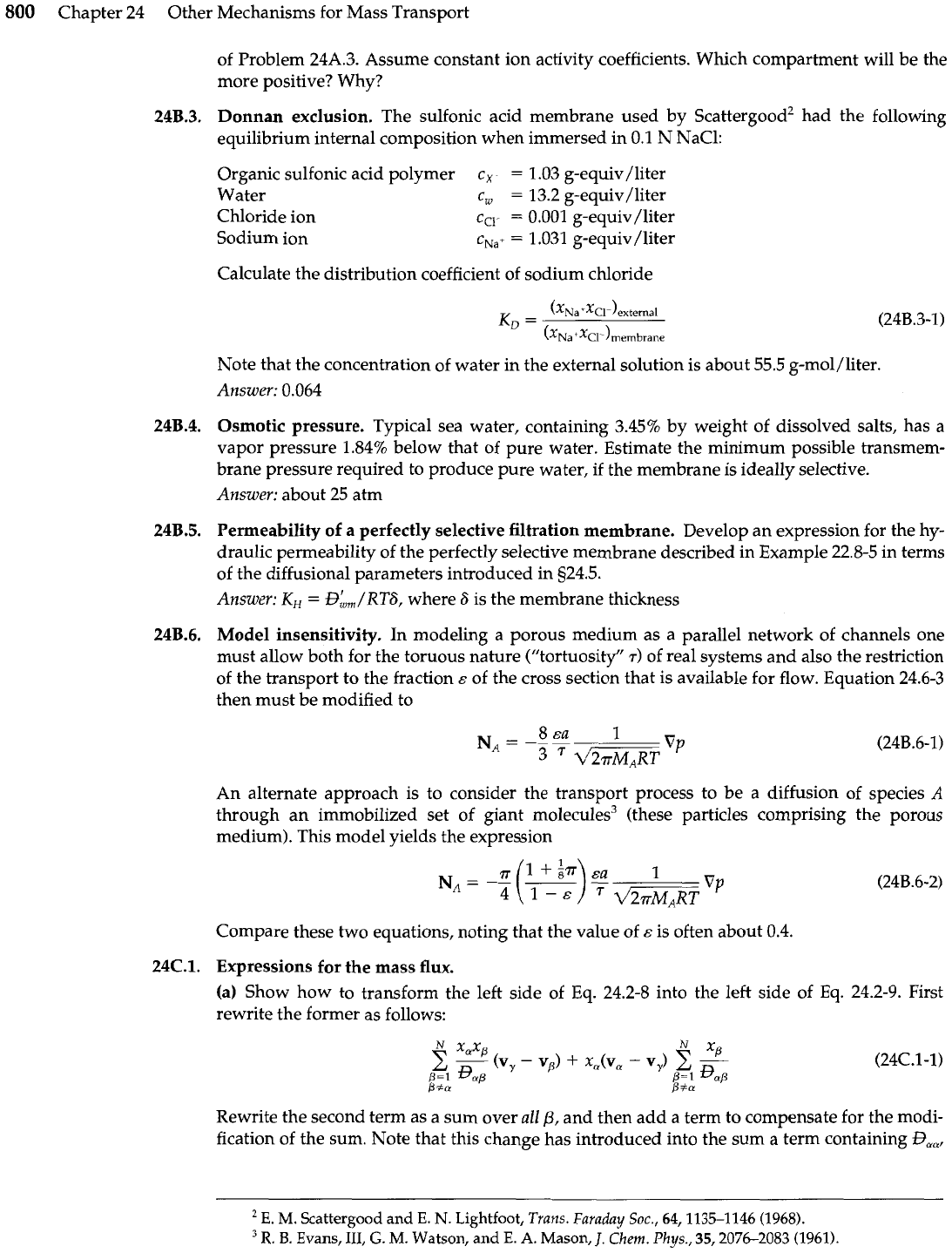
800
Chapter 24 Other Mechanisms for Mass Transport
of Problem 24A.3. Assume constant ion activity coefficients. Which compartment will be the
more positive? Why?
Donnan exclusion. The sulfonic acid membrane used by scattergood' had the following
equilibrium internal composition when immersed in 0.1 N NaC1:
Organic sulfonic acid polymer
c,
=
1.03 g-equiv/liter
Water
c,
=
13.2 g-equiv/liter
Chloride ion
c,--
=
0.001 g-equiv/liter
Sodium ion
c,,+
=
1.031 g-equiv/liter
Calculate the distribution coefficient of sodium chloride
Note that the concentration of water in the external solution is about 55.5 g-mol/liter.
Answer:
0.064
Osmotic pressure. Typical sea water, containing 3.45% by weight of dissolved salts, has a
vapor pressure 1.84% below that of pure water. Estimate the minimum possible transmem-
brane pressure required to produce pure water, if the membrane is ideally selective.
Answer:
about 25 atm
Permeability of
a
perfectly selective filtration membrane. Develop an expression for the hy-
draulic permeability of the perfectly selective membrane described in Example 22.8-5 in terms
of the diffusional parameters introduced in 324.5.
Answer:
KH
=
BLJRTS, where
6
is the membrane thickness
Model insensitivity. In modeling a porous medium as a parallel network of channels one
must allow both for the toruous nature ("tortuosity"
7)
of real systems and also the restriction
of the transport to the fraction
s
of the cross section that is available for flow. Equation 24.6-3
then must be modified to
An alternate approach is to consider the transport process to be a diffusion of species
A
through an immobilized set of giant molecules3 (these particles comprising the porous
medium). This model yields the expression
Compare these two equations, noting that the value of is often about 0.4.
Expressions for the mass
flux.
(a) Show how to transform the left side of Eq. 24.2-8 into the left side of Eq. 24.2-9. First
rewrite the former as follows:
Rewrite the second term as a sum over
all
p,
and then add a term to compensate for the modi-
fication of the sum. Note that this change has introduced into the sum a term containing Baa,
E.
M.
Scattergood and E.
N.
Lightfoot,
Trans. Faraday
Soc.,
64,1135-1146 (1968).
R.
B.
Evans,
111,
G.
M.
Watson, and
E.
A.
Mason,
J.
Chem. Phys.,
35,2076-2083
(1961).

Problems
801
which was not defined because it was not needed. Now, we are at liberty to define
B,,
in any
way we choose, and the choice we make is
XP
--X-
or
--
XP
Baa p=lDap
X-=o
P=1
Rp
Of,
all
p
This choice enables us to obtain the left side of Eq. 24.2-9, and also the auxiliary relation given
after Eq. 24.2-9 is, in fact, just Eq. 24C.1-3 above.
(b)
Next repeat the above derivation by replacing
vP
by
[vP
+
(DE/pp)V
In
TI,
and verify that
both the diffusion terms and the thermal diffusion terms of Eq. 24.2-8 may be transformed
into the corresponding terms in Eq. 24.2-9.
24C.2.
Differential centrifugation. The lysing (bursting) of
E.
coli cells has produced a dilute sus-
pension of inclusion bodies, hard insoluble aggregates of a desired protein, unlysed cells, and
unwanted dissolved proteins. For purposes of this problem all may be considered as spheres
with the properties indicated here.
Cells Inclusion bodies Proteins
Mass or equivalent 1.89
x
10
l2
g 2.32
X
10
l5
g 50 kilodaltons
Density (g/ml)
1
.07 1.3
1.3
Can these materials be effectively separated by centrifugation? Explain.
24C.3.
Transport characteristics of sodium chloride. In the accompanying table1 equivalent con-
ductance, diffusivity, and thermodynamic activity coefficients are given for sodium chloride
at 25°C. The first two are given as functions of the molarity (M), and the third for molality (m).
It may be assumed for the purposes of this problem that M/m
=
1
-
0.019m. Limiting ionic
equivalent conductances (that is, at infinite dilution) are 50.10 and 76.35, respectively. The salt
equivalent conductance in turn is defined as
where the specific conductance
KSp
=
L/AR,
where
X
is the resistance of a volume of solution
of length
L
and cross-sectional area
A.
Use these data to discuss the sensitivity of the solution
behavior to the three diffusivities
BNa1,, B,,
,,
and
BK,lcl
needed to describe this response
to solution concentration.
--
Electrochemical characteristics of aqueous NaCl solution at 25OC
Equivalent
Molar
conductance Diffusivity Molal
Activity
concentration (cm2/ohm-equiv) cm2/s
x
lo5
concentration coefficient
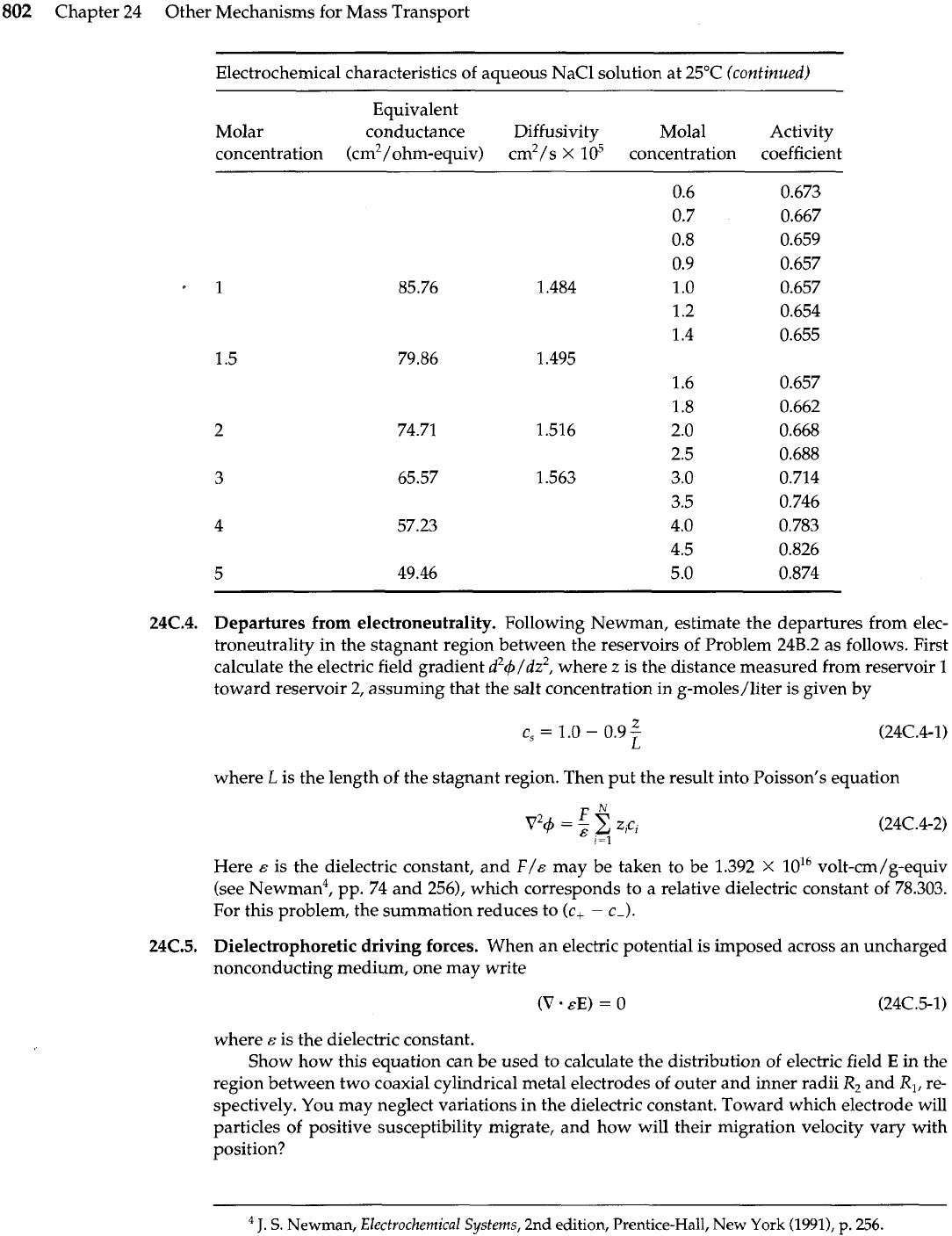
802
Chapter 24 Other Mechanisms for Mass Transport
Electrochemical characteristics of aqueous NaCl solution at 25OC
(continued)
-
Equivalent
Molar conductance
Diffusivity
Molal Activity
concentration (cm2/ohm-equiv) cm2 /s
X
1
O5
concentration coefficient
24C.4.
Departures from electroneutrality. Following Newman, estimate the departures from elec-
troneutrality in the stagnant region between the reservoirs of Problem
24B.2
as follows. First
calculate the electric field gradient d24/dz2, where z is the distance measured from reservoir
1
toward reservoir
2,
assuming that the salt concentration in g-moles/liter is given by
where
L
is the length of the stagnant region. Then put the result into Poisson's equation
Here
E
is the dielectric constant, and F/E may be taken to be 1.392
X
1016
volt-cm/g-equiv
(see Newman4, pp. 74 and 256), which corresponds to a relative dielectric constant of 78.303.
For this problem, the summation reduces to
(c,
-
c-).
24C.5.
Dielectrophoretic driving forces. When an electric potential is imposed across an uncharged
nonconducting medium, one may write
where
E
is the dielectric constant.
Show how this equation can be used to calculate the distribution of electric field
E
in the
region between two coaxial cylindrical metal electrodes of outer and inner radii R, and R,, re-
spectively. You may neglect variations in the dielectric constant. Toward which electrode will
particles of positive susceptibility migrate, and how will their migration velocity vary with
position?
-
-
J.
S.
Newman,
Electrochemical
Systems,
2nd
edition,
Prentice-Hall, New York (19911,
p.
256.
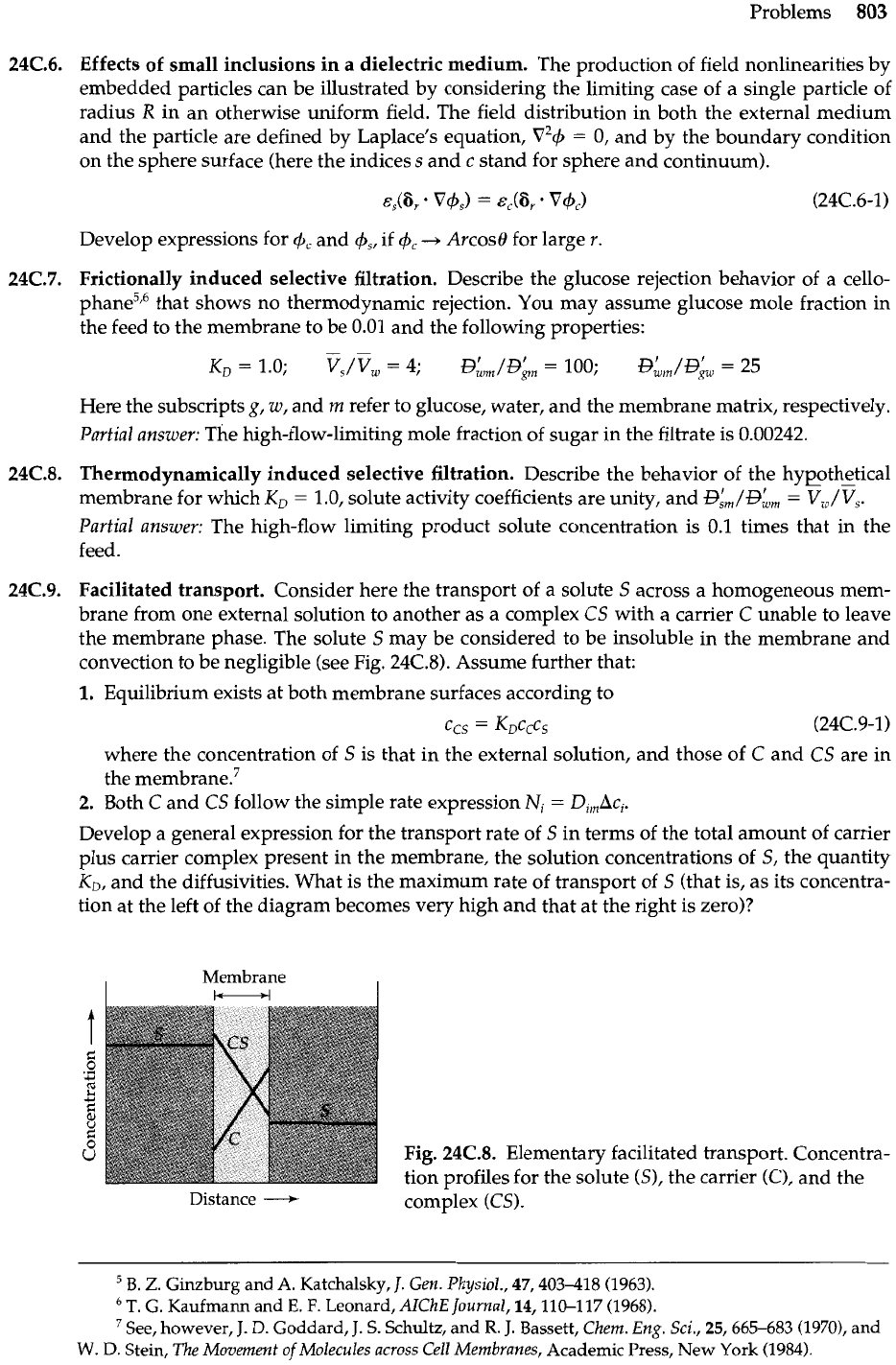
Problems
803
Effects
of
small inclusions in a dielectric medium. The production of field nonlinearities by
embedded particles can be illustrated by considering the limiting case of a single particle of
radius
R
in an otherwise uniform field. The field distribution in both the external medium
and the particle are defined by Laplace's equation,
V2+
=
0, and by the boundary condition
on the sphere surface (here the indices s and
c
stand for sphere and continuum).
Develop expressions for
4,
and
+,,
if
4,
-.
ArcosO for large r.
Frictionally induced selective filtration. Describe the glucose rejection behavior of a cello-
phane516 that shows no thermodynamic rejection. You may assume glucose mole fraction in
the feed to the membrane to be 0.01 and the following properties:
Here the subscripts
g,
w, and
rn
refer to glucose, water, and the membrane matrix, respectively.
Partial answer: The high-flow-limiting mole fraction of sugar in the filtrate is 0.00242.
Thermodynamically induced selective filtration. Describe the behavior of the hypothetical
membrane for which
KD
=
1.0, solute activity coefficients are unity, and
B,',/B~,,
=
v,,/V,.
Partial answer: The high-flow limiting product solute concentration is 0.1 times that in the
feed.
Facilitated transport. Consider here the transport of a solute S across a homogeneous mem-
brane from one external solution to another as a complex CS with a carrier C unable to leave
the membrane phase. The solute
S
may be considered to be insoluble in the membrane and
convection to be negligible (see Fig. 24C.8). Assume further that:
1.
Equilibrium exists at both membrane surfaces according to
ccs
=
K~c~cs
(24C.9-1)
where the concentration of S is that in the external solution, and those of C and CS are in
the membrane.7
2.
Both C and CS follow the simple rate expression
Ni
=
D,,Aci.
Develop a general expression for the transport rate of
S
in terms of the total amount of carrier
plus carrier complex present in the membrane, the solution concentrations of S, the quantity
K,,
and the diffusivities. What is the maximum rate of transport of S (that is, as its concentra-
tion at the left of the diagram becomes very high and that at the right is zero)?
I
Membrane
I
Fig.
24C.8.
Elementary facilitated transport. Concentra-
tion profiles for the solute (S), the carrier (C), and the
Distance
-
complex (CS).
B.
Z.
Ginzburg and
A.
Katchalsky,
J.
Gen. Physiol.,
47,403418 (1963).
T.
G.
Kaufmann and
E.
F.
Leonard,
AlChE Journal,
14,110-117 (1968).
See, however,
J.
D. Goddard,
J.
S.
Schultz, and
R.
J.
Bassett,
Chem. Eng. Sci.,
25,665-683 (1970),
and
W.
D. Stein,
The Movement
of
Molecules across Cell Membranes,
Academic Press, New York
(1984).

804
Chapter 24 Other Mechanisms for Mass Transport
24D.1.
Entropy
flux
and entropy production.
(a) Verify that Eqs. 24.1-3 and 4 follow from Eqs. 24.1-1 and
2.
(b)
Show that one can go backward from Eqs. 21.4-5 through
8
to Eqs. 24.1-3 and 4. To do this
it may be necessary to use one form of the Gibbs-Duhem equation,
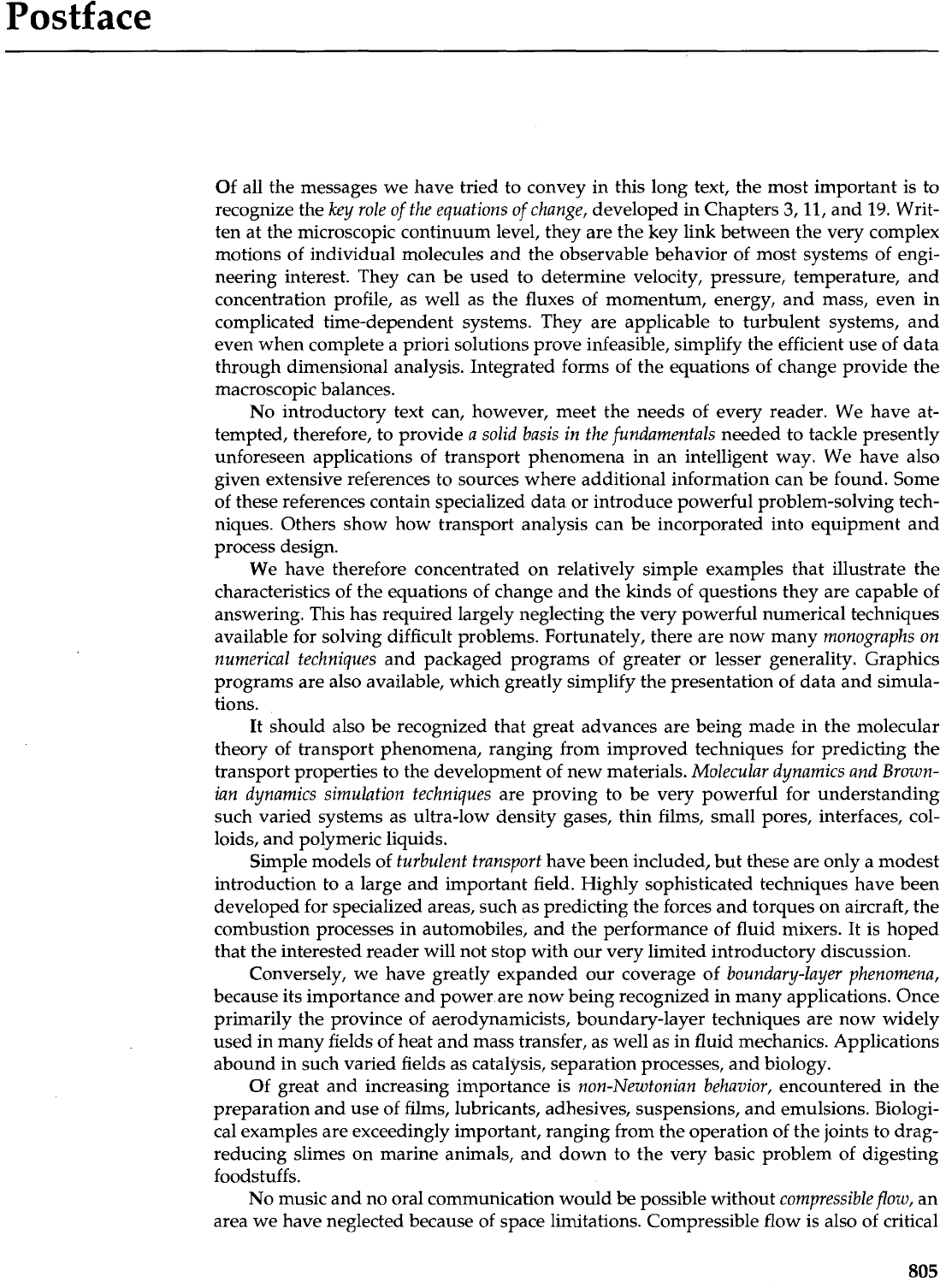
Postface
Of all the messages we have tried to convey in this long text, the most important is to
recognize the
key
role of the equations of change, developed in Chapters 3,11, and
19.
Writ-
ten at the microscopic continuum level, they are the key link between the very complex
motions of individual molecules and the observable behavior of most systems of engi-
neering interest. They can be used to determine velocity, pressure, temperature, and
concentration profile, as well as the fluxes of momentum, energy, and mass, even in
complicated time-dependent systems. They are applicable to turbulent systems, and
even when complete a priori solutions prove infeasible, simplify the efficient use of data
through dimensional analysis. Integrated forms of the equations of change provide the
macroscopic balances.
No introductory text can, however, meet the needs of every reader. We have at-
tempted, therefore, to provide a solid basis in the fundamentals needed to tackle presently
unforeseen applications of transport phenomena in an intelligent way. We have also
given extensive references to sources where additional information can be found. Some
of these references contain specialized data or introduce powerful problem-solving tech-
niques. Others show how transport analysis can be incorporated into equipment and
process design.
We have therefore concentrated on relatively simple examples that illustrate the
characteristics of the equations of change and the kinds of questions they are capable of
answering. This has required largely neglecting the very powerful numerical techniques
available for solving difficult problems. Fortunately, there are now many monographs
on
numerical techniques and packaged programs of greater or lesser generality. Graphics
programs are also available, which greatly simplify the presentation of data and simula-
tions.
It should also be recognized that great advances are being made in the molecular
theory of transport phenomena, ranging from improved techniques for predicting the
transport properties to the development of new materials. Molecular dynamics and Brown-
ian dynamics simulation techniques are proving to be very powerful for understanding
such varied systems as ultra-low density gases, thin films, small pores, interfaces, col-
loids, and polymeric liquids.
Simple models of turbulent transport have been included, but these are only a modest
introduction to a large and important field. Highly sophisticated techniques have been
developed for specialized areas, such as predicting the forces and torques on aircraft, the
combustion processes in automobiles, and the performance of fluid mixers. It is hoped
that the interested reader will not stop with our very limited introductory discussion.
Conversely, we have greatly expanded our coverage of boundary-layer phenomena,
because its importance and power are now being recognized in many applications. Once
primarily the province of aerodynamicists, boundary-layer techniques are now widely
used in many fields of heat and mass transfer, as well as in fluid mechanics. Applications
abound in such varied fields as catalysis, separation processes, and biology.
Of great and increasing importance is non-Newtonian behavior, encountered in the
preparation and use of films, lubricants, adhesives, suspensions, and emulsions. Biologi-
cal examples are exceedingly important, ranging from the operation of the joints to drag-
reducing slimes on marine animals, and down to the very basic problem of digesting
foodstuffs.
No music and no oral communication would be possible without compressible
pow,
an
area we have neglected because of space limitations. Compressible flow is also of critical
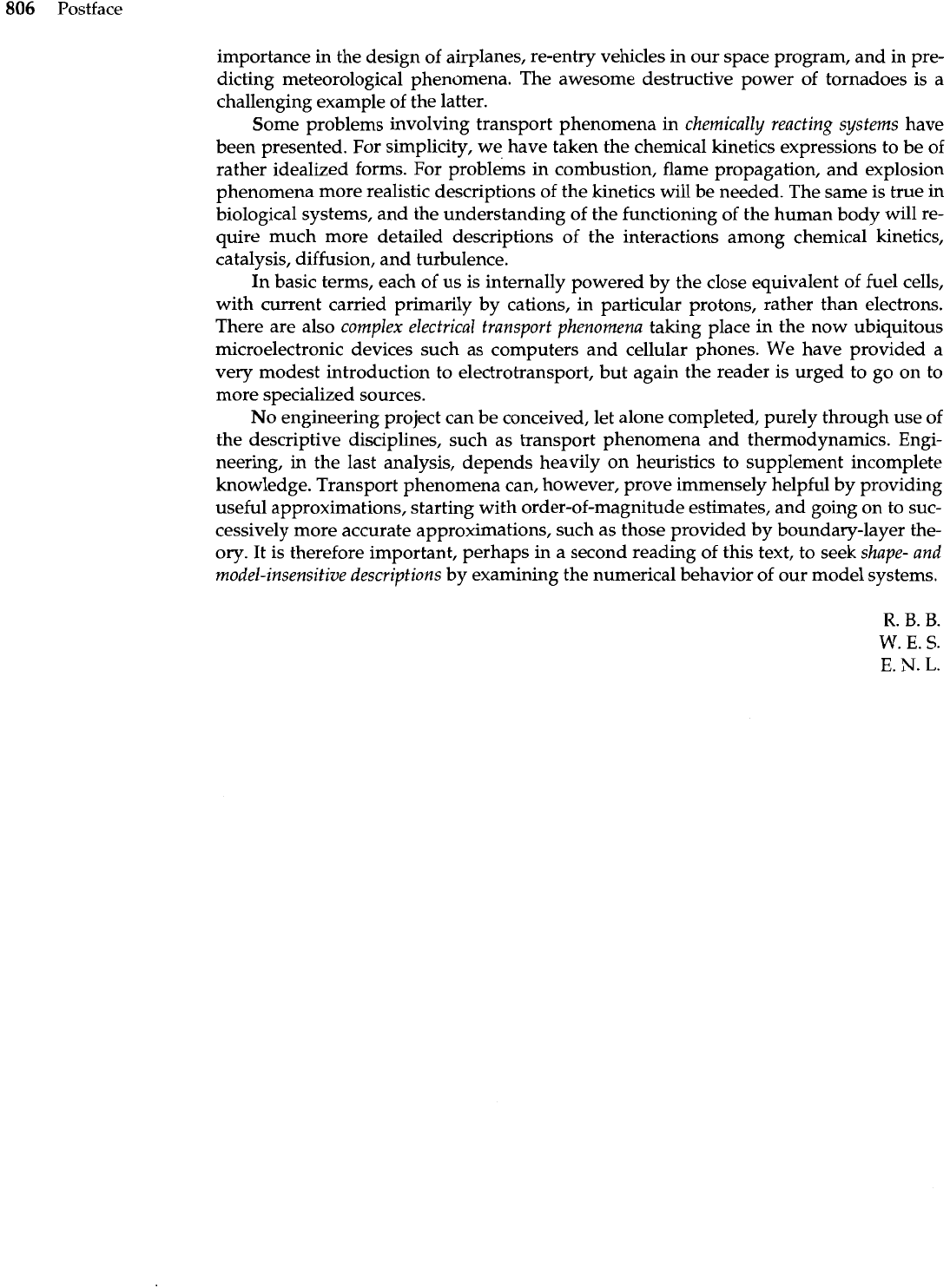
806
Postface
importance in the design of airplanes, re-entry vehicles in our space program, and in pre-
dicting meteorological phenomena. The awesome destructive power of tornadoes is a
challenging example of the latter.
Some problems involving transport phenomena in
chemically reacting systems
have
been presented. For simplicity, we have taken the chemical kinetics expressions to be of
rather idealized forms. For in combustion, flame propagation, and explosion
phenomena more realistic descriptions of the kinetics will be needed. The same is true in
biological systems, and the understanding of the functioning of the human body will re-
quire much more detailed descriptions of the interactions among chemical kinetics,
catalysis, diffusion, and turbulence.
In basic terms, each of us is internally powered by the close equivalent of fuel cells,
with current carried primarily by cations, in particular protons, rather than electrons.
There are also
complex electrical transport phenomena
taking place in the now ubiquitous
microelectronic devices such as computers and cellular phones. We have provided a
very modest introduction to electrotransport, but again the reader is urged to go on to
more specialized sources.
No engineering project can be conceived, let alone completed, purely through use of
the descriptive disciplines, such as transport phenomena and thermodynamics. Engi-
neering, in the last analysis, depends heavily on heuristics to supplement incomplete
knowledge. Transport phenomena can, however, prove immensely helpful by providing
useful approximations, starting with order-of-magnitude estimates, and going on to suc-
cessively more accurate approximations, such as those provided by boundary-layer the-
ory. It is therefore important, perhaps in a second reading of this text, to seek
shape- and
model-insensitive descriptions
by examining the numerical behavior of our model systems.
